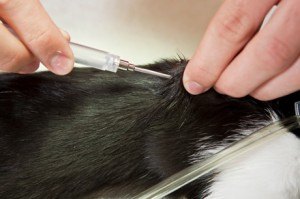Microchips Reunite Owners and Pets

Although not all shelters across the country are required to scan for microchips, North Carolina shelters now must do so. Senate Bill 626 requires shelters to scan all pets for a microchip. The information must be used to help reunite a pet with its owner. The AKC Companion Animal Recovery plan has pledged 20 universal microchip scanners to North Carolina shelters.
Sheila Goffe, Director of AKC Government Relations says, “AKC strongly supports common sense measures like this across the country that will help reunite lost pets with their owners in all communities.”
No one wants to feel the hurt and pain involved with losing your dog be it a big old Newfoundland or a tiny Teddy Bear pup. In the past, micro chipping was not as effective because there were so many different types of chips. Shelters could not afford all the different scanners required for the different chips, so they just went without in most cases. The process is much more centralized these days, which means the new bill in North Carolina could make a huge difference between losing a pup permanent and recovering it.
 If Your Dog is Lost or Stolen
If Your Dog is Lost or Stolen
A microchip will provide positive identification if your dog should ever become lost or stolen. Although, it is not a GPS device, it is common practice for shelters and veterinarians to scan for microchips. If your dog is found by a shelter, it can save countless hours of searching. Cases of stolen dogs are on the rise as well. Although not all stolen pets will be scanned unless there is suspicion, it can provide the necessary proof to ensure your ownership. It has been shown that dogs with microchips are twice as likely to make it home as those without.
You may have a plan for the rest of your family during a disaster, but what about your pets? It’s very easy for a pet to be separated from its family in the event of an emergency. Natural disasters cause terrible chaos. Rescue team and volunteers come together to gather lost pets. Social media sites and various websites are set up to help reunite pets and owners, but nothing is as reliable as the microchip. You could be browsing pictures for months.
Side Effects and Drawbacks
There have been 391 adverse reactions to microchips reported by dog owners since 1996. Over 4 million microchips have been placed, so this represents a miniscule risk level compared to the benefits. The main complaint is that occasionally the microchip can move from its original placement. This does make it more difficult to be certain it will be found, but most shelters are aware of the problem and do a full body scan when looking for chips. If you have concerns about the health risks associated with chipping a dog, speak with your vet to get the opinion of a professional.
How it Works
A microchip is inserted under the skin above the shoulder blades. It takes only seconds and is the size of a grain of rice. It will not fall off like a collar can. You must register your microchip number with your current information and keep it updated for it to be effective. To learn more about why you should microchip your dog, read one of my other blog entries here.
The bottom line is that for a small fee, you can take a big step in assuring the security of your beloved pet. It protects your ownership and is the best guarantee available to return your fur baby to you. We hope you never have to deal with the stress and heartache of a lost pet, but a microchip could be a lifesaver.
